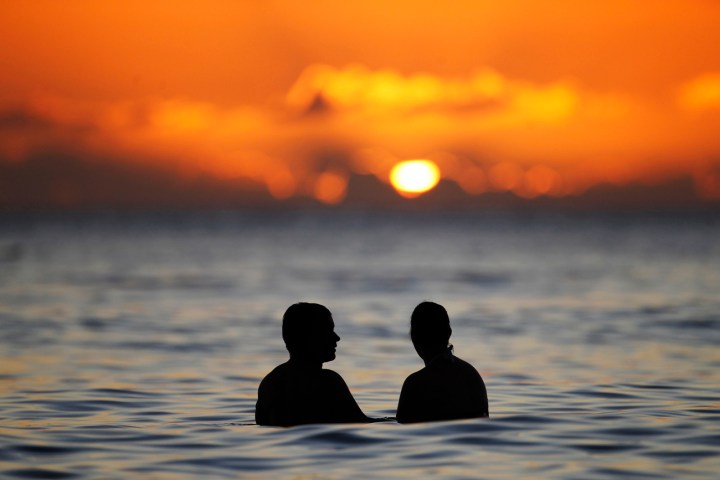Media
As inter-racial marriages climb to an all time high, the end of America’s final frontier is in sight

A real sea change has been slowly moving through American society for the past several generations in which people increasingly are jumping the racial fence – or just plain ignoring it. Now nearly two-thirds of Americans say "it would be fine" if a family member were to marry outside their own race. By J BROOKS SPECTOR.
Thirty-five years ago, while exploring one of the Smithsonian museums of Washington, this writer looked at an exhibition that explored the complex way racial differences had been portrayed in colonial America – in the Spanish and Portuguese colonies as well as the British and Dutch ones. From among all the items in this problematic but fascinating exhibition, one item stopped me in my tracks.
It was a beautifully embellished chart, painted on a square wooden panel, covered with Baroque flourishes. It had eight squares along its horizontal and eight along the vertical axes, thereby giving 64 individual squares in total. Each square contained a picture of a man and a woman – or the two of them with a child. At the upper left, the family was very European in appearance, while at the bottom right-hand corner, the three figures were virtually black. But in the other 62 blocks, the gradations described a visual dictionary of the whole racial typology of Latin America – mestizo, mulatto, quadroon, octoroon – and on into dizzyingly minute distinctions and categories. It was the world of sixteenth century law and sociology in miniature, illuminated through a table of human physical variety.
And of course, the legal status of the tiny people in each one of those 64 blocks was slightly different – from top-of-the-heap on down to much worse. But a further, more subliminal message of the chart, of course, was that – even back in the sixteenth century – there had already been a substantial mixing of the gene pool, bringing together Europeans, Asians, Amerindians and Africans for generations. And so it has been wherever and whenever the descendants of those original small groups of hunter-gatherers left Africa to populate the rest of the Earth some 70,000 years ago.
Of course, men (and it has usually been the men) have often tried to enforce prohibitions of intimacy between the different groups of people that evolved out of those ancient migrations – usually justifying these values on the basis of some incidental differences in the width of the bridge of the nose or skin colour (in association with manmade cultural traditions, languages and religions). Out of such a goal came apartheid in South Africa and Jim Crow segregation in the US. By the time such prohibitions had come to have legal sanction in South Africa, of course, whole populations of people had come into being, drawn upon the world’s gene pool. And the African American populations of the New World had come to hold genetic material from the whole world in their cell nuclei as well.
From the eighteenth century onward in the new United States, legal prohibitions increasingly made black-white interracial marriages (although certainly not sex) almost impossible under the presumptions of the so-called “one drop” rule: one drop of “African American blood” from children from such unions effectively African American as well. But as Eusebius McKaiser noted in his recent column in The New York Times, South Africa’s populations of mixed racial heritage have generally had more complex relationships with the vagaries and idiocies of racial categorisation than has historically been true in the United States.
South Africa’s premier social satirist, Pieter-Dirk Uys, had an entire cabaret routine that used to consist of simply reading from the parliamentary record the official notifications of people who had successfully petitioned the government to allow them to change their racial classification. He would solemnly read that so many Chinese became Indian, so many Coloured people became Indian, so many Whites had magically turned into Indians, Malays or Coloured South Africans. It would bring the house down every time.
Meanwhile, a real sea change has been slowly moving through American society for the past several generations in which people increasingly are jumping the racial fence there as well – or just plain ignoring it. A brand new Pew Research Centre study documents just how impressive this change has been.
According to the study released on 16 February, interracial marriages in the US have climbed to 4.8-million – a new high of 1 in 12 marriages. Besides changing attitudes, a key contributing element in this evolving pattern seems to be coming from the steady flow of new Asian and Hispanic immigrants that is considerably expanding the pool (and the diversity) of prospective spouses. Simultaneously, black Americans are now substantially more likely than before to marry whites as well.
Sociologist Daniel Lichter at Cornell University argues that based on the results of this survey, “The rise in interracial marriage indicates that race relations have improved over the past quarter century. Mixed-race children have blurred America’s colour line. They often interact with others on either side of the racial divide and frequently serve as brokers between friends and family members of different racial backgrounds [although] America still has a long way to go.”
The Pew study shows 8.4% of all current American marriages now are interracial, up sharply from 3.2% in 1980. While Hispanics and Asians remained the most likely, as in previous decades, to marry someone of a different race; somewhat surprisingly, the largest increase in share in the past four years has occurred among blacks, a population that historically has been the most segregated. Also, America’s western states with their large populations of Asian and Hispanic immigrants, were among the most likely to have couples who “marry out” – at 20%. The small, rural state of Vermont, by contrast, had a “marry out” rate of only 4%. Of course the state is almost entirely populated by white Americans so maybe they don’t meet too many people who don’t look like what they see in the mirror. Overall, more than 15% of all new marriages in 2010 were interracial in America – not quite the picture many would have expected before this study was released.
Such results also track other Pew surveys that have been measuring greater public acceptance of mixed marriage since 1967. In that year, the Supreme Court, taking the case of Loving vs. Virginia on appeal from the lower courts, declared racially based restrictions on marriage were unconstitutional (although the last such state law – in Alabama – long overlooked and unenforced, was finally revoked in 2000).
In its decision, the court had decided on “whether a statutory scheme adopted by the State of Virginia to prevent marriages between persons solely on the basis of racial classifications violates the Equal Protection and Due Process Clauses of the Fourteenth Amendment. For reasons which seem to us to reflect the central meaning of those constitutional commands, we conclude that these statutes cannot stand consistently with the Fourteenth Amendment.” Now, isn’t Loving v. Virginia the most appropriately named court case ever?
According to Pew’s new data, some 83% of Americans now agree it is “all right for blacks and whites to date each other,” up sharply from only 48% back in 1987. Meanwhile, nearly two-thirds said “it would be fine” if a family member were to marry outside their own race. Minorities, young adults, the higher educated and those living in Western or Northeast states also agreed mixed marriages represent a change for the better for society. On this issue, 61% of 18-29-year-olds agreed, in contrast to only 28% of those 65 and above.
Taken together, multiracial Americans (beyond all those who carry genetic variety from history, of course) are one of the country’s fastest-growing demographic groups and they now represent about 9-million people. The Census Bureau now estimates that s multi-racial people, blacks, Hispanics and Asians will – collectively – equal more than half the total population of the country by 2050.
According to the Pew report, more than a quarter of all Hispanics and Asians who married in 2010 had a spouse of a different race, while over 17% of blacks and almost one in 10 whites did as well. When one stops and contemplates those numbers, they sound suspiciously like the family tree of the current residents of the White House, along with many other American families.
Finally, among all of the 275,500 new interracial marriages concluded in 2010, 43% were white-Hispanic, 14.4% were white-Asian, 11.9% were white-black, and the remainder came from other, more interesting – or unusual – combinations. For example, when the writer last lived in the Washington area, one of his younger daughter’s best friends was a child whose parents were Iranian and Korean. Such is the growing power of social mixing and the growing diversity of the American population as a whole.
Paul Taylor, director of Pew’s Social & Demographic Trends project comments “In the past century, intermarriage has evolved from being illegal, to be a taboo and then to be merely unusual. And with each passing year, it becomes less unusual. That says a lot about the state of race relations. Behaviours have changed and attitudes have changed… For younger Americans, racial and ethnic diversity are a part of their lives.”
Now, this being an election year in America and thus a period when everything can be observed through the lens of electoral contests, the writer can not help but wonder what effect such trends will have on American politics in future. Beginning with the Obama election of 2008, will all future presidential tickets now strive to include individuals that engage with the increasingly interwoven racial texture of American families, thereby capturing the changing demographics of the US? After all, for decades, successful electoral politics in New York City, the great melting pot as it was labelled, always aimed for a potent mix of candidates for major elected offices, each drawn from among all the major hyphenated American and voter groups of the city – Jews, blacks, Hispanics, Irish- and Italian-Americans – and eventually Asian-Americans as well.
It is more than a little ironic, of course, that in light of the Loving decision, the state with the highest rate of white-black married couples in America is now nowhere else than Virginia – the very same state that 150 years ago was the core of the Confederacy in a revolt against the federal union that was predicated upon preserving African American slavery. DM
Read more:
- The Rise of Intermarriage at the Pew Research Center website.
- For all the data on US population, the US Census Bureau website.
- What Does It Mean to Be Human? At the Smithsonian Institution website.
- Loving v. Virginia (No. 395) 206 Va. 924, 147 S.E.2d 78, reversed at the Cornell Law School website.
- Interracial marriage in US hits new high: 1 in 12.
- Not White Enough, Not Black Enough, a column by Eusebius McKaiser.
Photo: With inter-racial marriages on the up, has America reached (and overcome) it’s final racial boundary? REUTERS/Jason Reed.



















 Become an Insider
Become an Insider